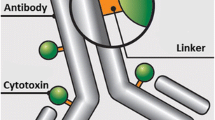Abstract
Type 1 insulin-like growth factor receptor (IGF-1R) is a promising therapeutic target for cancer treatment. A single-chain variable fragment (scFv) against human IGF-1R forms inclusion body when expressed in periplasmic space of E. coli routinely. Here, we described that co-expression of appropriate disulfide bonds (Dsb) proteins known to catalyze the formation and isomerization of Dsb can markedly recover the soluble expression of target scFv in E. coli. A 50 % recovery in solubility of the scFv was observed upon co-expression of DsbC alone, and a maximum solubility (80 %) was obtained when DsbA and DsbC were co-expressed in combination. Furthermore, the soluble scFv present full antigen-binding activity with IGF-1R, suggesting its correct folding. This study also suggested that the selection of Dsb proteins should be tested case-by-case if the approach of co-expression of Dsb system is adopted to address the problem of insoluble expression of proteins carrying Dsb.




Similar content being viewed by others
References
Arcaro A (2013) Targeting the insulin-like growth factor-1 receptor in human cancer. Front Pharmacol 4:30
Baxter RC (2000) Insulin-like growth factor (IGF)-binding proteins: interactions with IGFs and intrinsic bioactivities. Am J Physiol Endocrinol Metab 278:E967–E976
Bessette PH, Åslund F, Beckwith J, Georgiou G (1999) Efficient folding of proteins with multiple disulfide bonds in the Escherichia coli cytoplasm. Proc Natl Acad Sci U S A 96:13703–13708
Bulieris PV, Behrens S, Holst O, Kleinschmidt JH (2003) Folding and insertion of the outer membrane protein OmpA is assisted by the chaperone Skp and by lipopolysaccharide. J Biol Chem 278:9092–9099
Couprie J, Vinci F, Dugave C, Quemeneur E, Moutiez M (2000) Investigation of the DsbA mechanism through the synthesis and analysis of an irreversible enzyme-ligand complex. Biochemistry 39:6732–6742
de Marco A (2009) Strategies for successful recombinant expression of disulfide bond- dependent proteins in Escherichia coli. Microb Cell Fact 8:26
Depuydt M, Messens J, Collet JF (2011) How proteins form disulfide bonds. Antioxid Redox Signal 15:49–66
Gallagher EJ, LeRoith D (2010) The proliferating role of insulin and insulin-like growth factors in cancer. Trends Endocrinol Metab 21:610–618
Gleiter S, Bardwell JC (2008) Disulfide bond isomerization in prokaryotes. Biochim Biophys Acta 1783:530–534
Gualberto A (2010) Figitumumab (CP-751,871) for cancer therapy. Expert Opin Biol Ther 10:575–585
Heras B, Edeling MA, Schirra HJ, Raina S, Martin JL (2004) Crystal structures of the DsbG disulfide isomerase reveal an unstable disulfide. Proc Natl Acad Sci U S A 101(24):8876–8881
Inaba K (2009) Disulfide bond formation system in Escherichia coli. J Biochem 146(5):591–597
Jurado P, Ritz D, Beckwith J, de Lorenzo V, Fernández LA (2002) Production of functional single-chain Fv antibodies in the cytoplasm of Escherichia coli. J Mol Biol 320:1–10
Kadokura H, Katzen F, Beckwith J (2003) Protein disulfide bond formation in prokaryotes. Annu Rev Biochem 72:111–135
Kurokawa Y, Yanagi H, Yura T (2001) Overproduction of bacterial protein disulfide isomerase (DsbC) and its modulator (DsbD) markedly enhances periplasmic production of human nerve growth factor in Escherichia coli. J Biol Chem 276:14393–14399
Levy R, Weiss R, Chen G, Iverson BL, Georgiou G (2001) Production of correctly folded Fab antibody fragment in the cytoplasm of Escherichia coli trxB gor mutants via the coexpression of molecular chaperones. Protein Expr Purif 23:338–347
Liddy N, Molloy PE, Bennett AD, Boulter JM, Jakobsen BK, Li Y (2010) Production of a soluble disulfide bond-linked TCR in the cytoplasm of Escherichia coli trxB gor mutants. Mol Biotechnol 45:140–149
Maskos K, Huber-Wunderlich M, Glockshuber R (2003) DsbA and DsbC-catalyzed oxidative folding of proteins with complex disulfide bridge patterns in vitro and in vivo. J Mol Biol 325:495–513
Masuda K, Richter M, Song X et al (2005) AHNP-streptavidin: a tetrameric bacterially produced antibody surrogate fusion protein against p185her2/neu. Oncogene 25:7740–7746
Messens J, Collet JF (2006) Pathways of disulfide bond formation in Escherichia coli. Int J Biochem Cell Biol 38:1050–1062
Ortenberg R, Beckwith J (2003) Functions of thiol-disulfide oxidoreductases in E. coli: redox myths, realities, and practicalities. Antioxid Redox Signal 5:403–411
Ow DSW, Lim DYX, Nissom PM et al (2010) Co-expression of Skp and FkpA chaperones improves cell viability and alters the global expression of stress response genes during scFvD1.3 production. Microb Cell Fact 9:22
Pollak M (2008) Insulin and insulin-like growth factor signalling in neoplasia. Nat Rev Cancer 8:915–928
Schlapschy M, Skerra A (2011) Periplasmic chaperones used to enhance functional secretion of proteins in E. coli. Methods Mol Biol 705:211–224
Shao F, Bader MW, Jakob U, Bardwell JC (2000) DsbG, a protein disulfide isomerase with chaperone activity. J Biol Chem 275:13349–13352
Walton TA, Sousa MC (2004) Crystal structure of Skp, a prefoldin-like chaperone that protects soluble and membrane proteins from aggregation. Mol Cell 15:367–374
Zhang Z, Li ZH, Wang F et al (2002) Overexpression of DsbC and DsbG markedly improves soluble and functional expression of single-chain Fv antibodies in Escherichia coli. Protein Expr Purif 26:218–228
Acknowledgments
We thank our anonymous reviewers for useful suggestions. We thank Dr. Ma for critically reading the manuscript.
Conflict of interest
The authors declare that they have no conflict of interest.
Author information
Authors and Affiliations
Corresponding author
Rights and permissions
About this article
Cite this article
Sun, XW., Wang, XH. & Yao, YB. Co-expression of Dsb proteins enables soluble expression of a single-chain variable fragment (scFv) against human type 1 insulin-like growth factor receptor (IGF-1R) in E. coli . World J Microbiol Biotechnol 30, 3221–3227 (2014). https://doi.org/10.1007/s11274-014-1749-2
Received:
Accepted:
Published:
Issue Date:
DOI: https://doi.org/10.1007/s11274-014-1749-2




